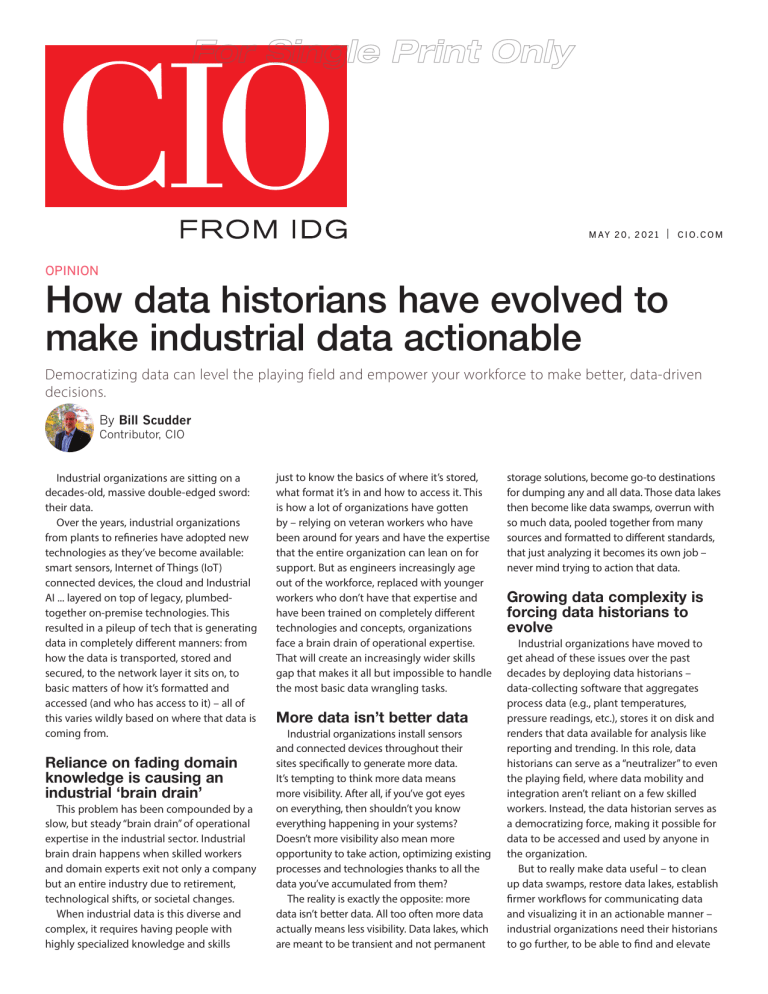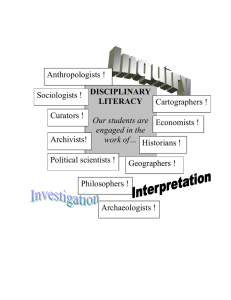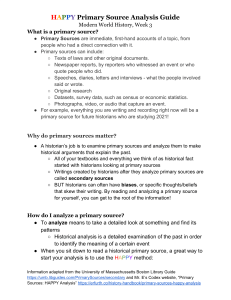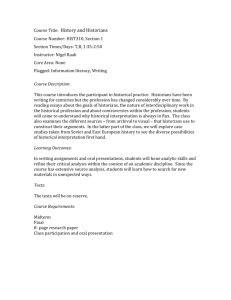Industrial Data Historians: Evolution & Actionable Insights
advertisement

M AY 2 0 , 2 0 2 1 | CIO.COM OPINION How data historians have evolved to make industrial data actionable Democratizing data can level the playing field and empower your workforce to make better, data-driven decisions. By Bill Scudder Contributor, CIO Industrial organizations are sitting on a decades-old, massive double-edged sword: their data. Over the years, industrial organizations from plants to refineries have adopted new technologies as they’ve become available: smart sensors, Internet of Things (IoT) connected devices, the cloud and Industrial AI ... layered on top of legacy, plumbedtogether on-premise technologies. This resulted in a pileup of tech that is generating data in completely different manners: from how the data is transported, stored and secured, to the network layer it sits on, to basic matters of how it’s formatted and accessed (and who has access to it) – all of this varies wildly based on where that data is coming from. Reliance on fading domain knowledge is causing an industrial ‘brain drain’ This problem has been compounded by a slow, but steady “brain drain” of operational expertise in the industrial sector. Industrial brain drain happens when skilled workers and domain experts exit not only a company but an entire industry due to retirement, technological shifts, or societal changes. When industrial data is this diverse and complex, it requires having people with highly specialized knowledge and skills just to know the basics of where it’s stored, what format it’s in and how to access it. This is how a lot of organizations have gotten by – relying on veteran workers who have been around for years and have the expertise that the entire organization can lean on for support. But as engineers increasingly age out of the workforce, replaced with younger workers who don’t have that expertise and have been trained on completely different technologies and concepts, organizations face a brain drain of operational expertise. That will create an increasingly wider skills gap that makes it all but impossible to handle the most basic data wrangling tasks. More data isn’t better data Industrial organizations install sensors and connected devices throughout their sites specifically to generate more data. It’s tempting to think more data means more visibility. After all, if you’ve got eyes on everything, then shouldn’t you know everything happening in your systems? Doesn’t more visibility also mean more opportunity to take action, optimizing existing processes and technologies thanks to all the data you’ve accumulated from them? The reality is exactly the opposite: more data isn’t better data. All too often more data actually means less visibility. Data lakes, which are meant to be transient and not permanent storage solutions, become go-to destinations for dumping any and all data. Those data lakes then become like data swamps, overrun with so much data, pooled together from many sources and formatted to different standards, that just analyzing it becomes its own job – never mind trying to action that data. Growing data complexity is forcing data historians to evolve Industrial organizations have moved to get ahead of these issues over the past decades by deploying data historians – data-collecting software that aggregates process data (e.g., plant temperatures, pressure readings, etc.), stores it on disk and renders that data available for analysis like reporting and trending. In this role, data historians can serve as a “neutralizer” to even the playing field, where data mobility and integration aren’t reliant on a few skilled workers. Instead, the data historian serves as a democratizing force, making it possible for data to be accessed and used by anyone in the organization. But to really make data useful – to clean up data swamps, restore data lakes, establish firmer workflows for communicating data and visualizing it in an actionable manner – industrial organizations need their historians to go further, to be able to find and elevate data based on relevancy. That means identifying relevant data, correlations and events with tags, mapping the relationships between them, and mobilizing those datasets as they’re relevant to various end user personas. Data historians have to evolve, moving beyond standardized aggregations of process data to become the anchor technology for industrial data-management strategies. Industrial organizations have to switch their focus from mass data accumulation to strategic industrial data management, specifically homing in on data integration, data mobility and data accessibility across the organization – with the goal of using AI-enabled technologies to unlock hidden value in previously unoptimized and undiscovered sets of industrial data. The next generation of data historians will drive the next generation of the industrial workforce Today’s operations have changed significantly; the simple reporting of 10 or 20 years ago doesn’t cut it. Next-gen data historians have to be able to scale up, speed up and connect across a multitude of real-time industrial applications to keep up with the evolution and complexity of industrial data facing organizations right now. These needs are exacerbated by nextgen requirements for connecting across multiple plant sites, scaling up and down based on site complexity, and increasing the needs for high availability and edge-to-cloud convergence. These new enterprise-grade data historians also provide a seamless bridge and integrate industrial data across existing data historians with cloud-ready solutions. This approach democratizes the data so any worker, of varied areas of expertise or background, can draw on it successfully to transform raw data into actionable business decisions, as and when needed –making them a critical business value accelerator in the digital transformation of industrial organizations. When data is no longer spread out across different formats and standards, and is instead made equally accessible and consumable, it’s no longer bound to the individual skills or expertise of certain workers, be it data scientists, data analysts or operational users –it empowers diverse roles across industrial organizations with data-driven decision-making capabilities. Not only does this help close the skills gap, it also makes the worker’s day-to-day routine that much easier and more productive – elevating their roles to more strategic tasks. Collecting data is no longer a process of integrating with different vendors or chasing down specific people carrying USB keys with the data you need, just for basic access. It eliminates the need to trawl different databases like Oracle, SQL or figure out the complexity associated with the growing slew of cloud-enabled databases. Connecting people to data There is a major business imperative to transform existing data historians into nextgeneration, enterprise-grade data historians, capable of supporting the production agility and business performance goals of the industrial sector. Of course, this is only half the battle. How industrial organizations visualize data, run machine learning algorithms on it, put it into workflows and make it consumable is the final step in making raw data – or data living in various formats – truly actionable. And to enable that final step, industrial organizations need to adopt a cloud-ready infrastructure purpose-built for industrial AI applications that can streamline how these users access and act on data. But you can’t reach that final step without taking the first one of cleaning, formatting, tagging and standardizing data –by having a harmonized industrial data-management strategy and a robust data pipeline that helps get the industrial data to an AI-ready state. Doing so doesn’t require physically changing your data sources or a complete forklift approach. Next-gen data historians serve as an effective go-between, bridging the gap with existing data historian solutions, changing workflows and making data easier to discover, consolidate and access. This not only facilitates greater collaboration between data scientists and process engineers on how they access and use data – it also helps close an emerging skills gap exacerbated by a changing workforce. No more throwing new workers fresh out of school onto legacy technology they don’t understand; no more brain drains caused by retiring employees; and no more chasing down people on the floor for their USB keys just to find the right data. Leveraging a nextgeneration, enterprise-grade data historian connects your people to the data they need, however they need it, whenever they need it. Bill Scudder is Senior Vice President and General Manager, Artificial Intelligence of Things (AIoT) Solutions, at AspenTech. He previously served as the company’s Senior Vice President and Chief Information Officer, and remains responsible for the company’s IT organization. Posted with permission from CIO. Copyright © 2021. All rights reserved. #C114553 Managed by The YGS Group, 800.290.5460. For more information visit www.theYGSgroup.com.







